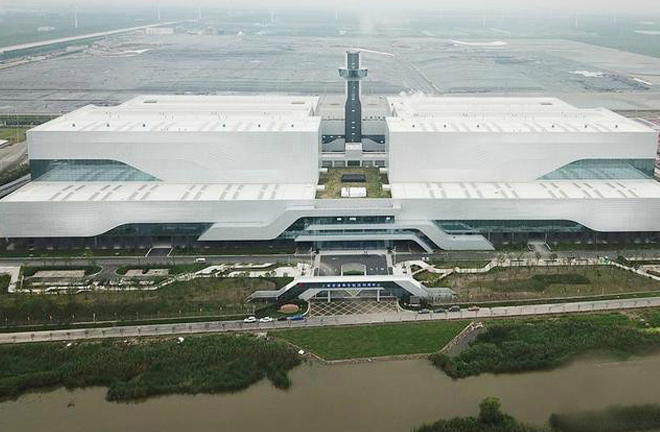Waste sorting in China makes initial achievements

This picture shows the second phase construction of Shanghai’s Laogang Renewable Resource Recycling Center. The incineration power plant is the largest of its kind and capable of processing around 2.7 million tons of waste per year. Photo: Fang Zhe/XINHUA
In the past two years, China’s waste sorting work has progressed as it has covered more regions and become more comprehensive.
First, the laws for waste sorting are being consolidated. Garbage classification is a nuanced social governance responsibility whose effectiveness and progress are largely determined by a society’s level of legal implementation. The State Council executive meeting has adopted a draft of the Law on Prevention and Control of Environmental Pollution by Solid Waste, which regulated household waste sorting for the first time.
The draft law requires a household waste sorting system covering collection, transportation and disposal. Forty-six cities have formulated mandatory household waste sorting plans according to their local characteristics, and nearly 30 of them have enacted regulations and management measures. Shanghai, Xiamen, Ningbo, Hangzhou and other pioneers have tailored methods backed by fines targeting the working units and residents who don’t sort waste and the companies who transport waste without classification.
The collaborative role of local governments is increasing. Waste sorting is a complicated and arduous systematic project involving many departments. It must be coordinated as a whole and systematically planned and promoted at multiple government levels. This work used to be a lonely fight for sanitation departments, but now things need to change. At present, more and more cities have established a comprehensive coordination office or mechanism for garbage sorting led by local government and supported by multiple departments. In some cities, Party and government leaders are responsible for managing trash sorting to clarify roles and responsibilities and cement supervision and evaluation. Therefore, the efficiency and effectiveness of waste sorting have been improved.
At the same time, a cultural atmosphere of universal participation is taking shape. Garbage classification requires the participation of all people. In-depth publicity and education are needed to guide public opinion and cultivate habits. At present, central committee organizations, troops stationed in Beijing and provincial agencies have all started garbage sorting, and they will mobilize more people and groups to join the force. Diverse forms of traditional and emerging media surveys and reports on waste sorting are becoming more abundant, professional and insightful, leading to mounting social attention on garbage sorting. Relevant data show that a total of 19 million households have received information related to household waste sorting. More and more people are becoming aware of this issue.
At last, facilities’ ability to dispose of different kinds of waste continues to improve. These facilities are central to the domestic waste sorting system. In 2018, the harmless treatment rate of urban domestic garbage reached 98.2%, and methods of sanitary landfill and incineration with power generation were equally adopted. Although China still has no ideal equipment for waste sorting and processing, a bedrock for the large-scale implementation of a garbage sorting system has formed. Without the proper equipment, waste sorting cannot reduce the processing system’s working pressure or raise its quality and efficiency. Compared with some developed countries in Europe and the United States, China’s waste sorting facilities fail to achieve high-quality incineration with power generation, standardized recycling and whole-chain biological treatment, and the whole waste processing structure has flaws. At present, economically powerful cities such as Beijing, Shanghai, Shenzhen, Guangzhou, Ningbo, Suzhou and even underdeveloped cities in the west such as Lanzhou and Yinchuan have already initiated the planning and construction of waste sorting and processing facilities.
Over the past two years, China’s efforts in waste sorting have had a good start in terms of preparatory work, mechanism establishment and responsibility clarification. The country has also made progressive accomplishments in boosting efficiency and building garbage sorting patterns.
This article was translated from Guangming Daily.
edited by CHEN MIRONG
